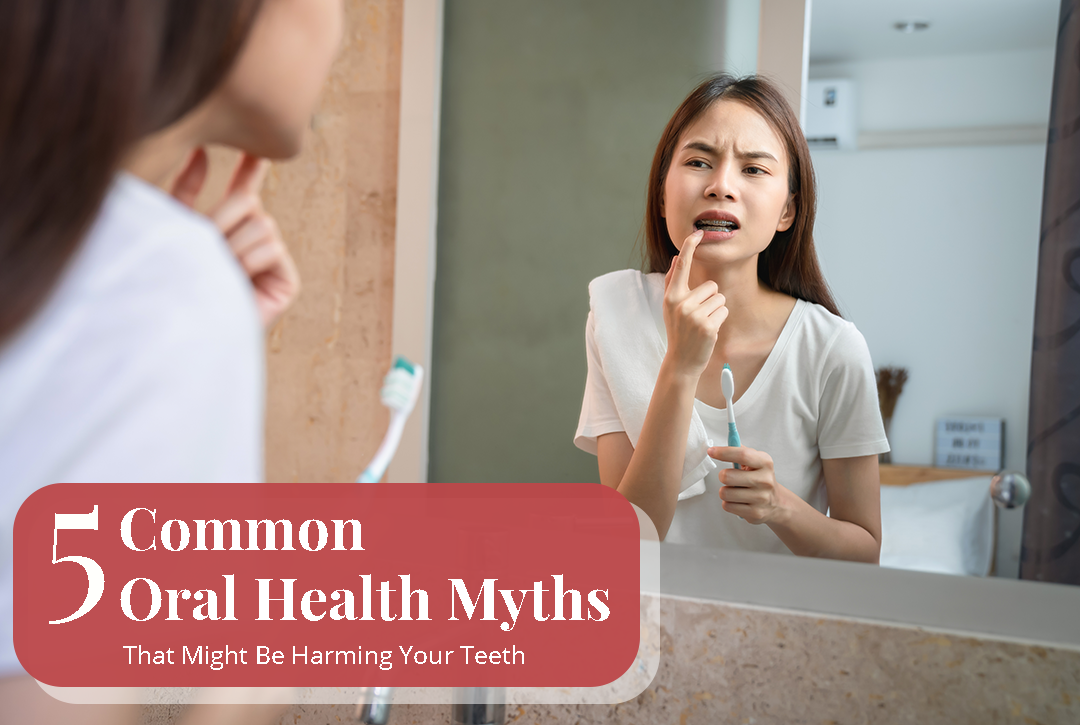5 Common Oral Health Myths That Might Be Harming Your Teeth

We all know that brushing our teeth is the bare minimum for oral hygiene, but did you also know that certain brushing habits may adversely affect your oral health? Engaging in wrong habits and routine are often due to a lack of oral health knowledge.
When it comes to maintaining good oral health, here are five common myths that we have debunked to help you learn the right facts.
Myth 1: Teeth is Cleaner if I Brush Harder
Vigorous brushing is not an ideal technique for cleaning your teeth. In fact, the harder you brush, the more damage you are causing to your enamel and gum tissues. This counterproductive method can lead to several oral health problems such as receding gums and enamel abrasion that can eventually result in tooth sensitivity.
Many also believe that firm or hard-bristled toothbrushes last longer and clean more thoroughly than soft bristles. This is not true because hard bristles are unable to reach most surfaces of our teeth due to their curvature. As a result, plaque bacteria tend to accumulate and contribute to dental cavities.
Furthermore, scrubbing your teeth with firm bristles may cause irreversible abrasion to the tooth enamel, which is a protective layer that cannot be regenerated once it wears down. Gum recession is also a common dental problem caused by using hard toothbrushes on a regular basis.
Tip:
Opt for a soft-bristled toothbrush to gently and thoroughly brush your teeth twice daily. With the correct brushing technique, soft toothbrushes can help remove plaque and debris more effectively while being gentle on your gums and enamel.
Myth 2: Flossing is Unnecessary
Flossing is integral to maintaining good oral health as it helps remove plaque and food particles between your teeth that toothbrushes cannot reach. Many dentists recommend flossing at least once or twice a day to reduce the likelihood of tooth decay and gum disease.
However, incorrect flossing technique can lead to problems such as bleeding, gum recession, and cavities. Learn how to use your dental floss properly by following these steps:
- Break off approximately 45cm of floss and wrap each end around both of your middle fingers.
- Hold the floss tightly between your thumbs and index fingers.
- Place the floss gently between your teeth and glide it up and down using soft rubbing motions against both sides of each tooth.
- As the floss reaches the gum, curve the floss into a C shape and gently slide it into the space between the gum and the tooth. Avoid snapping the floss into your gum.
- Repeat the steps while moving tooth by tooth. Floss each tooth with a clean section of the floss.
It is normal to experience bleeding if you are flossing for the first time. However, consult a dentist immediately should you encounter persistent or severe bleeding.
If you find conventional flossing a hassle, there are alternative tools to make your flossing routine a breeze. Floss picks, water or electric flossers, and interdental brushes are some of the dental tools that are equally effective in removing food debris and bacteria.
Myth 3: Sugar-free Drinks Are Harmless to My Teeth
It is a common belief that regular soda or other sugar-laden beverages contribute to tooth decay and cavities due to their high sugar content. Unfortunately, sugar-free drinks are equally harmful. They usually contain high levels of acids that are culprits for enamel erosion and tooth decay.
Tip:
To minimise such risks, drink through a straw or rinse your mouth with water to wash off any remaining acids after drinking acidic beverages. However, it is advisable to wait at least half an hour before brushing your teeth. This is because brushing can further damage the enamel that have just been attacked by acid. Alternatively, the obvious solution is to consume in moderation or substitute your fluids entirely with water instead.
Myth 4: Charcoal Toothpaste Works Better
There has been a growing trend in charcoal toothpastes that claim to be effective in teeth whitening and removing surface stains. Although charcoal helps remove superficial stains, the abrasive nature of charcoal may damage your tooth enamel in the long run. When the enamel wears down, teeth will appear yellow and become susceptible to sensitivity.
Bonus fact:
While pearly whites are often associated with youthfulness and cleanliness, they do not necessarily indicate good oral health. Just as white teeth are not necessarily healthy, off-coloured teeth are not necessarily bad either. However, discolouration can sometimes signify decay or other dental problems, so it is recommended to visit a dentist if you notice stains on your teeth.
Myth 5: I Only Need to See a Dentist if I have Dental Problems
As the saying goes, prevention is better than cure. A dental checkup can help detect and prevent oral health problems before they start. The longer these problems go undiagnosed or untreated, the harder it is to treat them. A dental checkup should therefore be scheduled every six months to maintain optimal oral health.
Oral health is often a reflection of our overall health. Therefore, it is important not to neglect dental care. If you are ever in doubt, consult a trusted dentist who can provide the right advice to help you maintain a healthy set of teeth and an everlasting smile.




















